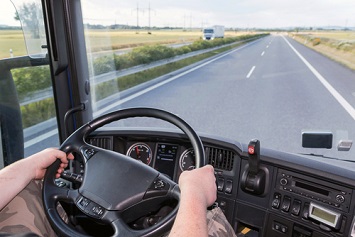The Centers for Disease Control and Prevention (CDC) have issued guidelines for long-haul truckers concerned about their health during the COVID-19 pandemic. The guidelines cover both steps truckers can take themselves and practices employers should adopt to protect the health and safety of their employees.
COVID-19 is a respiratory illness caused by the SARS-CoV-2 virus.
While long-haul truckers spend many hours alone in a truck cab, there are times when they are at increased risk of exposure to SARS-CoV-2. Potential sources of exposure include close contact with dock workers, other truck drivers, store workers, truck stop attendants, or others with COVID-19, then touching their nose, mouth, or eyes after contacting surfaces touched or handled by a person with COVID-19.
The CDC recommends limiting close contact with others, maintaining a distance of at least 6 feet whenever possible. Steps truckers can take to limit close contact include:
- Keeping the truck cab well ventilated and limiting time spent outside the truck cab during fueling, loading, and unloading, as well as at rest and truck stops;
- Using paperless, electronic invoicing for deliveries, fueling, and other tasks, when available;
- Contacting facilities in advance to make an appointment for unloading cargo;
- Being aware that some facilities may not grant access to restrooms and planning accordingly;
- Using radios or mobile phones, if possible, to talk with dock managers or other drivers;
- Packing food, water, and supplies to limit the number of stops; and
- Avoiding shaking hands.
The CDC recommends wearing cloth face coverings in public settings, especially in areas with significant community-based transmission. The CDC also encourages proper hand hygiene, washing hands regularly with soap and water for 20 seconds or using alcohol-based hand sanitizer containing at least 60% alcohol.
The CDC also recommends cleaning and disinfecting frequently touched surfaces on a routine basis, such as the air ducts, arm and head rests, dashboard, driver door handle, seat belt and buckle, seat cover, steering wheel, radio, temperature controls, turn signal, and wiper controls in the truck cab, as well as light switches, the mattress tray, temperature controls, and other flat surfaces in the sleeper berth; drivers should use products on the EPA’s List N that are effective against SARS-CoV-2.
If a third party such as an inspector, a mechanic, or other must have access to the interior of the truck, then the driver should request that the third party clean and disinfect the truck before returning it to the driver. Drivers who must travel in teams should wear cloth face coverings in the truck cab and avoid sharing bedding in the sleeper berth.
Drivers should use prequalified truck stops or hotels identified by their employer as having appropriate COVID-19 protections.
Employer Precautions
Steps that employers should take to protect their employees include:
- Encouraging sick drivers to stay home and not allowing drivers diagnosed with COVID-19 to return to work until they have met the CDC criteria for ending home isolation;
- Providing drivers with accurate information about COVID-19, as well as all personal protective equipment (PPE) they might need while on the road (including hard hats, safety glasses, and vests) so they do not need to borrow PPE from shippers, alcohol-based hand sanitizers containing at least 60% alcohol, cleaners and disinfectants, tissues, and small trash bins for truck cabs;
- Developing policies and technology options that allow and encourage contactless deliveries, such as no-signature delivery to limit contact, provide space, and avoid the sharing of items like pens and electronic signature pads between drivers and individuals at the delivery location;
- Limiting ride-alongs and in-person, classroom-based training;
- Prequalifying truck stops, rest areas, and hotels to ensure such facilities are open and supplied and follow recommended COVID-19 safety practices, such as cleanliness and disinfection, contactless fuel payment, and proper food handling and food service; and
- Designating a person who is responsible for responding to COVID-19 concerns and ensuring all drivers know who this person is and how to contact him or her.

